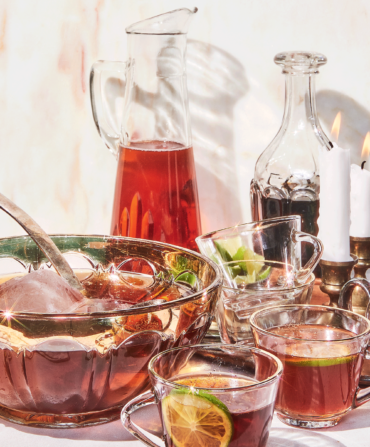Punch has historically been more concept than commodity. It was built around a simple idea rather than a specific product: that you could sand down the rough edges of a harsh spirit—and keep a crowd happy—with some well-considered additions, which came to include sugar, citrus juice, and spices, along with tea or (later) soda.
The first written reference to punch arose in India in 1632 (penned in a letter by a British traveler), and from there the notion overspread the globe, although rather slowly since ships were then the chief form of social media. Punch was originally concocted from palm-sap liquor, but then brandy and whiskey took over when the drink reached Europe. Punch next made a fateful and fortuitous leap to the West Indies, with its sugar crops and bottomless barrels of rum. By the end of that century, it had arrived in the American colonies.

Johnny Autry
Throughout it all, punch has remained the most democratic of drinks. Taverns throughout the colonies set out bowls awaiting customers, and many prided themselves on the excellence of their offerings. Alice Morse Earle, the author of Stage-Coach and Tavern Days, noted, “Sometimes honor was conferred by naming the punch for the person,” then added, perhaps uncharitably, that “sometimes the punch was the only honor the original ever had.”
Classic Punch Recipes
From the 1600s: Classic West Indian Punch
From the 1700s/1800s: Quoit Club Punch
From the 1900s: Champagne Punch
From the 2000s: Satsuma Punch
Pro Punch Move: Make a Oleo-Saccharum
Punch persisted through the nineteenth century—commentators noted that some bowls of it were large enough that geese could swim in them. But then came the upstart cocktail—individually sized, endlessly customizable, attractively modern—and punch began its long sunset. By the middle of the twentieth century, it was largely exiled to bridge clubs and Ladies Auxiliaries. Worse yet, college fraternities took a liking to it, and so random liquor and random juices all went into trash-cans-as-punch-bowls, in the unsound belief that this was how adults drank. The death knell came when a mirthless, alcohol-free version entered the exitless mire of bottled drinks for children.
With the revival of sophisticated drinking among younger generations over the past decade, punch has happily reemerged, thanks in large part to cocktail historians such as David Wondrich, whose 2010 book, Punch: The Delights (and Dangers) of the Flowing Bowl, resurrected antiquarian recipes. Rum-and-lime-heavy West Indian punches of the seventeenth century and Madeira-spiked ones of the eighteenth seem right at home alongside sparkling post-Prohibition concoctions from the twentieth. Punch has by now all but recovered from the indignity of fraternity and bridge parties, and bowls of thoroughly modern mixes regularly appear at hip bars in Atlanta and New Orleans and Washington, D.C., offering both traditional hospitality as well as a beverage that makes the palate dance.
Welcome back, friend.
Classic Punch Recipes
From the 1600s: Classic West Indian Punch
From the 1700s/1800s: Quoit Club Punch
From the 1900s: Champagne Punch
From the 2000s: Satsuma Punch
Pro Punch Move: Make a Oleo-Saccharum








